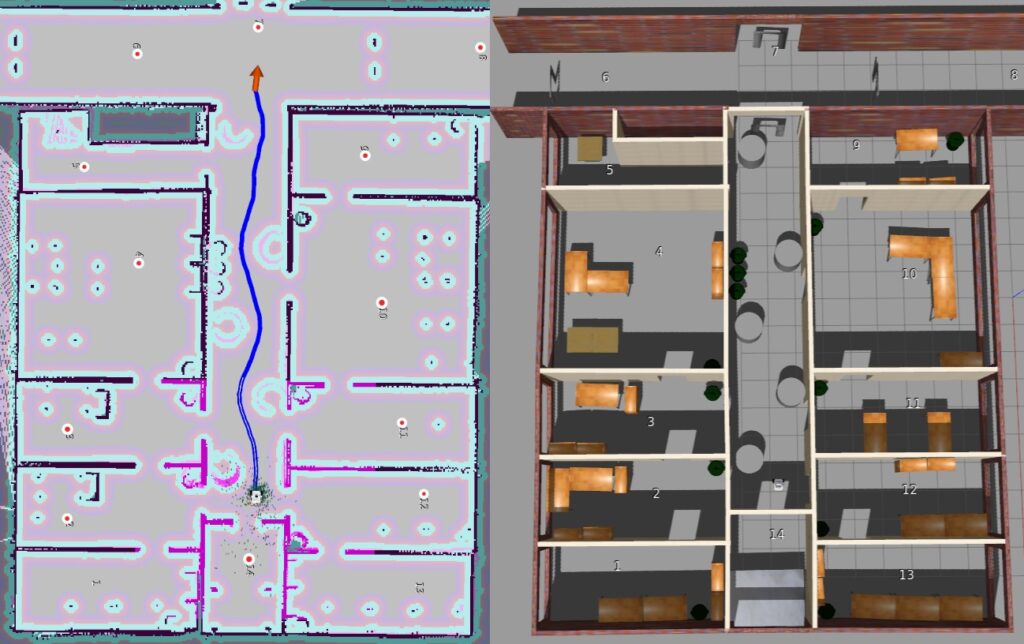M.Sc. Thesis – Stefan Maintinger: Map-based and map-less mobile navigation in crowded dynamic environments
Supervisor: Linus Nwankwo, M.Sc.;
Vedant Dave M.Sc.;
Univ.-Prof. Dr Elmar Rückert
Start date: 1st June 2023
Theoretical difficulty: mid
Practical difficulty: mid
Abstract

For more than two decades now, the technique of simultaneous localization and mapping (SLAM) has served as a cornerstone in achieving goals related to autonomous navigation.
The core essence of the SLAM problem lies in the creation of an environmental map while concurrently estimating the robot’s relative position to this map. This task is undertaken with the aid of sensor observations and control data, both of which are subject to noise.
In recent times, a shift towards a mapless-based approach employing deep reinforcement learning has emerged. In this innovative methodology, the agent, in this case a robot, learns the navigation policy. This learning process is driven solely by sensor data and control data, effectively bypassing the need for a prior map of the task environment. In the scope of this dissertation, we will conduct a comprehensive performance evaluation of both the traditional SLAM and the emerging mapless-based approach. We’ll utilize a dynamic, crowded environment as our test bed, and the open-source open-shuttle mobile robot with a differential drive will serve as our experimental subject.
Tentative Work Plan
To achieve our objective, the following concrete tasks will be focused on:
- Literature research and field familiarization
- Mobile robotics and industrial use cases
- Overview of map-based autonomous navigation (SLAM & Path planning)
- Overview of mapless-based autonomous navigation approach with deep reinforcement learning
- Setup and familiarize with the simulation environment
- Build the robot model (URDF) for the simulation (optional if you wish to use the existing one)
- Setup the ROS framework for the simulation (Gazebo, Rviz)
- Recommended programming tools: C++, Python, Matlab
- Intermediate presentation:
- Presenting the results of the literature study
- Possibility to ask questions about the theoretical background
- Detailed planning of the next steps
- Define key performance/quality metrics for evaluation:
- Time to reach the desired goal
- Average/mean speed
- Path smoothness
- Obstacle avoidance/distance to obstacles
- Computational requirement
- Success rate
- Other relevant parameters
- Assessment and execution:
- Compare the results from both map-based and map-less approaches on the above-defined evaluation metrics.
- Validation:
- Validate both approaches in a real-world scenario using our open-source open-shuttle mobile robot.
- Furthermore, the following optional goals are planned:
- Develop a hybrid approach combining both the map-based and the map-less methods.
- M.Sc. thesis writing
- Research paper writing (optional)
Related Work
[1] Xue, Honghu; Hein, Benedikt; Bakr, Mohamed; Schildbach, Georg; Abel, Bengt; Rueckert, Elmar, “Using Deep Reinforcement Learning with Automatic Curriculum Learning for Mapless Navigation in Intralogistics“, In: Applied Sciences (MDPI), Special Issue on Intelligent Robotics, 2022.
[2] Han Hu; Kaicheng Zhang; Aaron Hao Tan; Michael Ruan; Christopher Agia; Goldie Nejat “Sim-to-Real Pipeline for Deep Reinforcement Learning for Autonomous Robot Navigation in Cluttered Rough Terrain”, IEEE Robotics and Automation Letters ( Volume: 6, Issue: 4, October 2021).
[3] Md. A. K. Niloy; Anika Shama; Ripon K. Chakrabortty; Michael J. Ryan; Faisal R. Badal; Z. Tasneem; Md H. Ahamed; S. I. Mo, “Critical Design and Control Issues of Indoor Autonomous Mobile Robots: A Review”, IEEE Access ( Volume: 9), February 2021.
[4] Ning Wang, Yabiao Wang, Yuming Zhao, Yong Wang and Zhigang Li , “Sim-to-Real: Mapless Navigation for USVs Using Deep Reinforcement Learning”, Journal of Marine Science and Engineering, 2022, 10, 895. https://doi.org/10.3390/jmse10070895